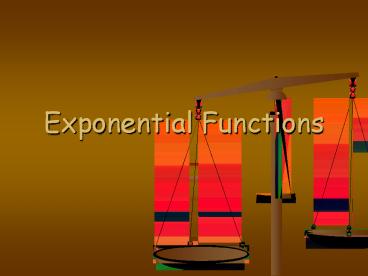Exponential Functions PowerPoint PPT Presentation
Title: Exponential Functions
1
Exponential Functions
2
- A function that can be expressed in the form
- and is positive,
is called an Exponential Function.
3
Vocabulary Asymptote
- Exponential functions have a graph characteristic
called an asymptote. - An asymptote is an imaginary line the graphs
infinite behavior approaches.
4
- Exponential Function
- Graph Characteristics
- The parent exponential function has a y-intercept
at (0,1). - The parent exponential function has an asymptote
at y 0. - The value of b determines the steepness of the
curve. - There are no local extrema.
5
More Characteristics of
- The domain is
- The range is
- End Behavior
- As
- As
- The y-intercept is
- The horizontal asymptote is
- There is no x-intercept.
- There are no vertical asymptotes.
- This is a continuous function.
- It is concave up.
6
- How would you graph
Domain Range Y-intercept
Horizontal Asymptote
Inc/dec?
increasing
Concavity?
up
- How would you graph
Domain Range Y-intercept
Horizontal Asymptote
Inc/dec?
increasing
up
Concavity?
7
- How would you graph
Is this graph increasing or decreasing?
Decreasing.
- Notice that the reflection is decreasing, so the
end behavior is
8
How do a and b affect the function?
- 4 typse of graphs
- a and bgt1, then f is an exponential growth
- -a and b gt1, then f is reflected down
- 3) a and 0ltblt1, then f is an exponential decay
- 4) a and 0ltblt1, then f is reflected down
9
Transformations
- Exponential graphs, like other functions we have
studied, can be dilated, - reflected and translated.
- It is important to maintain the same base as you
analyze the transformations.
Reflect _at_ x-axis Vertical stretch 3 Vertical
shift down 1
Vertical shift up 3
10
More Transformations
Reflect about the x-axis.
Vertical shrink ½ .
Horizontal shift left 2.
Horizontal shift right 1.
Vertical shift up 1.
Vertical shift down 3.
Domain
Domain
Range
Range
Horizontal Asymptote
Horizontal Asymptote
Y-intercept
Y-intercept
Inc/dec?
Inc/dec?
decreasing
increasing
Concavity?
Concavity?
down
up
11
More Transformations
- In general, transformations of the exponential
parent function - involve some combination of the following
formula
12
The number e
- The number e has the value 2.71828 and possesses
special calculus properties that simplify many
calculations and is also called the natural base
of exponential functions. - The function is called the Natural
Exponential Function
13
Domain Range Y-intercept H.A.
Continuous Increasing No vertical asymptotes
and
14
Transformations
Vertical stretch 3.
Horizontal shift left 2.
Reflect _at_ x-axis.
Vertical shift up 2
Vertical shift up 2.
Vertical shift down 1.
Domain Range Y-intercept H.A.
Domain Range Y-intercept H.A.
Domain Range Y-intercept H.A.
Inc/dec?
increasing
Inc/dec?
increasing
Inc/dec?
decreasing
Concavity?
up
Concavity?
up
Concavity?
down

